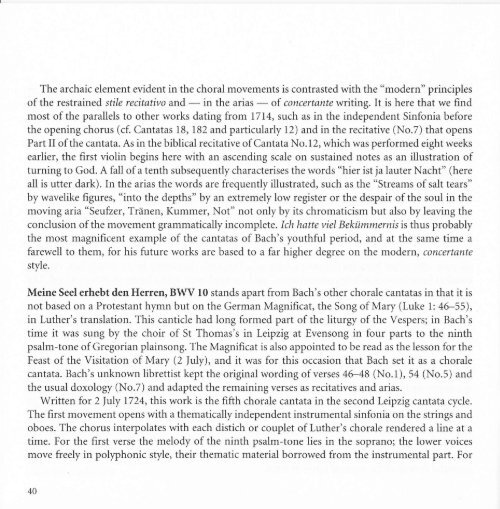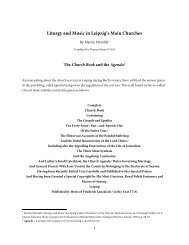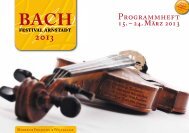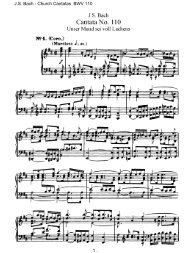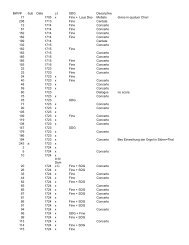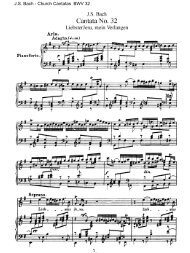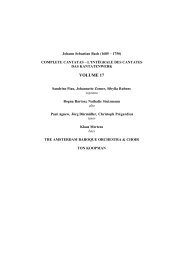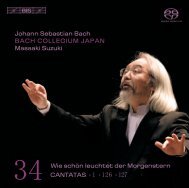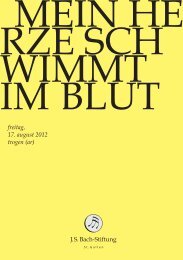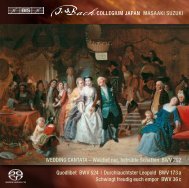Bach Cantatas, Vol. 2 - F. Werner (Erato 10-CD)
Bach Cantatas, Vol. 2 - F. Werner (Erato 10-CD)
Bach Cantatas, Vol. 2 - F. Werner (Erato 10-CD)
You also want an ePaper? Increase the reach of your titles
YUMPU automatically turns print PDFs into web optimized ePapers that Google loves.
The archaic element evident in the choral movements is contrasted with the "modern" principles<br />
of the restrained stile recitativo and<br />
-<br />
in the arias<br />
-<br />
of concertantewriting. It is here that we find<br />
most of the parallels to other works dating from 1714, such as in the independent Sinfonia before<br />
the opening chorus (cf. <strong>Cantatas</strong> 18, 182 and particularly 12) and in the recitative (No.7) that opens<br />
Part II of the cantata. As in the biblical recitative of Cantata No.12, which was performed eight weeks<br />
earlier, the first violin begins here with an ascending scale on sustained notes as an illustration of<br />
turning to God. A fall of a tenth subsequently characterises the words "hier ist ja lauter Nacht" (here<br />
all is utter dark). In the arias the words are frequently illustrated, such as the "Streams of salt tears"<br />
by wavelike figures, "into the depths" by an extremely low register or the despair of the soul in the<br />
moving aria "Seufzer, Tränen, Kummer, Not" not only by its chromaticism but also by leaving the<br />
conclusion of the movement grammatically incomplete. Ich hatte viel Bekümmernis is thus probably<br />
the most magnificent example of the cantatas of <strong>Bach</strong>'s youthful period, and at the same time a<br />
farewell to them, for his future works are based to a far higher degree on the modern, concertante<br />
style.<br />
Meine Seel erhebt den Herren, BWV <strong>10</strong> stands apart from <strong>Bach</strong>'s other chorale cantatas in that it is<br />
not based on a Protestant hyrnn but on the German Magnificat, the Song of Mary (Luke 1: 46-55),<br />
in Luther's translation. This canticle had long formed part of the liturgy of the Vespers; in <strong>Bach</strong>'s<br />
time it was sung by the choir of St Thomas's in Leipzig at Evensong in four parts to the ninth<br />
psalm-tone of Gregorian plainsong. The Magnificat is also appointed to be read as the lesson for the<br />
Feast of the Visitation of Mary (2 July), and it was for this occasion that <strong>Bach</strong> set it as a chorale<br />
cantata. <strong>Bach</strong>'s unknown librettist kept the original wording of verses 46-48 (No.1), 54 (No.5) and<br />
the usual doxology (No.7) and adapted the remaining verses as recitatives and arias.<br />
Written for 2July 1724,this work is the fifth chorale cantata in the second Leipzigcantata cycle.<br />
The first movement opens with a thematically independent instrumental sinfonia on the strings and<br />
oboes. The chorus interpolates with each distich or couplet of Luther's chorale rendered a line at a<br />
time. For the first verse the melody of the ninth psalm-tone lies in the soprano; the lower voices<br />
move freely in pollphonic style, their thematic material borrowed from the instrumental part. For<br />
40


